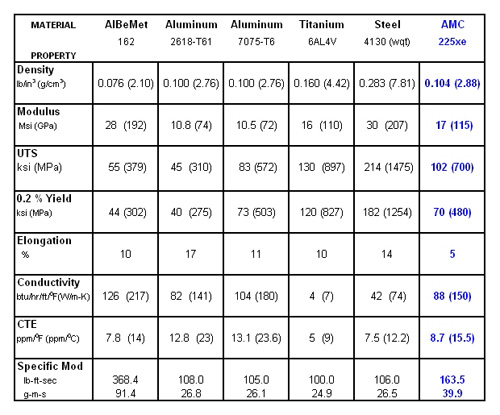MMC Finds More Motor Sport Applications
 There are several successful applications of Metal Matrix Composite (MMC) materials in Formula One, although their use in engines is currently banned. MMCs have also been used in other forms of motorsport, and are finding an ever-increasing number of interesting applications.A Metal Matrix Composite can be defined as an engineered material made from at least two substances, at least one of which is a metal, each having substantially different chemical or physical properties, and each of which remain distinct from each other in the end product, as opposed to a compound, in which the materials are chemically combined at the molecular level.
There are several successful applications of Metal Matrix Composite (MMC) materials in Formula One, although their use in engines is currently banned. MMCs have also been used in other forms of motorsport, and are finding an ever-increasing number of interesting applications.A Metal Matrix Composite can be defined as an engineered material made from at least two substances, at least one of which is a metal, each having substantially different chemical or physical properties, and each of which remain distinct from each other in the end product, as opposed to a compound, in which the materials are chemically combined at the molecular level.
While an MMC can be composed of two metals, most MMC's are combinations of a metal and a ceramic. The metal provides the monolithic, continuous structure into which the reinforcement particles are embedded, and provide a compliant support for the reinforcing particles. Some of the most common MMC's are various alloys of Aluminium (Al) reinforced with particles of Silicon Carbide (SiC).This article spotlights the properties of one specific MMC (AMC-225xe) and some of its varied uses in motor sports. These uses include pistons, cylinder liners, con rods, rocker arms, valve spring retainers and suspension uprights.AMC-225xe is 75% (volume) high-strength Aluminium-Copper alloy (AA-2124) and 25% Silicon Carbide. It's manufacture is based in powder metallurgy techniques, and includes (a) steps to produce ultra fine (2-3 micron) particles of the metal and the ceramic components, (b) the proprietary high-energy mixing process which assures an extremely homogeneous distribution of the components, (c) the HIP-based compaction of the mixture into billets, (d) the forming of the final product (forging, rolling, extrusion), and (e) the appropriate heat treatments.Table One shows the physical properties of AMC 225xe compared to certain other high performance materials. (AlBeMet-162 (62% Beryllium), which was outlawed for political reasons several years ago, is included in the table to illustrate the extremes of MMC technology.)Specific Modulus, one of the most definitive properties, is a non-dimensional number obtained by dividing the Young's Modulus (stiffness) by the density. 225xe has essentially the same density as aluminium alloys, yet is stiffer than Titanium 6AL4V. That is reflected by the Specific Modulus, which is about 60% greater than the aluminium, titanium and steel samples, and interestingly, just under the Formula One regulatory maximum of 40.0.The strength and fatigue performance of this material is also noteworthy, with a room temperature tensile strength 2.25 times greater than 2618 (a popular piston alloy). One company has done its own independent rotating-beam fatigue tests, which show that at 21°C and 150°C, the 10-million cycle survival stress is over 2.25 times greater than that of 2618. It is important to note that this material is isotropic, so the designer need not be concerned with different longitudinal and lateral strength and fatigue performance.

Table One: Comparison of Key Properties
Compared to 2618, the coefficient of thermal expansion (CTE) is 32% less and the thermal conductivity is about 7% greater. These properties make it clear why an MMC piston can be designed either for the same life with a much-reduced weight, for much longer survival at the same weight, or some combination of greater life with reduced weight.Several years ago, one CART team began using cylinder liners from 225xe to address a longevity problem in that highly-turbocharged application. The new liners lasted so well that they could be re-used during two rebuild cycles. Currently, a major piston manufacturer has developed a big-bore kit for motorcycle engines using a 225xe liner.One company offers a line of 225xe con rods for popular 250, 450 and 650cc single-cylinder 4-stroke motorcycle racing applications. These one-piece rods, for built-up crankshafts with roller bearings, originally came with a pressed-in steel outer race for the rollers. Next, they eliminated the pressed-in steel race and ran the rollers directly on the con rod MMC surface. The current products now run with NO rollers. The MMC big-end surface forms a hydrodynamic bearing against the journal, without any coatings.While no steady-state power gains have been attributable to the use of these conrods, there has been a dramatic improvement in transient acceleration performance. They are nearly half the weight of the steel pieces they replace, which allows the counterweighting on the crankshaft to be lightened dramatically in the rebalancing, significantly reducing the mass moment of inertia of the crankshaft. That reduction also serves to reduce the gyroscopic moment which the engine generates during yaw and roll manoeuvring. Some teams report being able to eliminate the counterbalance shaft which some of the engines use to reduce engine vibration. Drivers report that the engines-sans-balance shaft are no worse than the original setup.